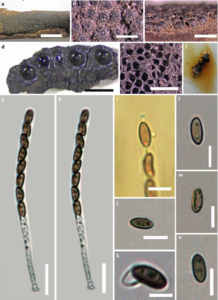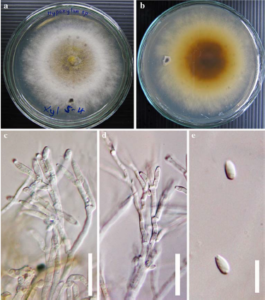Annulohypoxylon nitens (Ces.) Y.M. Ju, J.D. Rogers & H.M. Hsieh, Mycologia 97(4): 861 (2005)
Index Fungorum number: IF 345156; Facesoffungi number: FoF00029.
Isotype – IMI 339738
Saprobic on corticated and decorticated wood. Sexual morph: Ascostromata 0.5–7 × 0.25–5 × 0.07–0.2 cm thick (x̄ = 4.5 × 3.5 × 0.12 cm), glomerate, hemisphaerical to effuse pulvinate, with perithecial mounds exposing up to 1/4–1/2; when young surface dark brown vinaceous (84), becoming blackish at maturity, with reddish-brown tone, finally shiny black; blackish granules immediately beneath surface, with KOH-extractable pigments, greenish-olivaceous (90), woody tissue below the perithecial layer, blackish, perithecia 0.5–1 mm diam. (x̄ = 0.7 mm), sphaerical, ostioles conical-papillate, encircled with a flattened bovei-type disc, 0.2–0.5 mm diam. (x̄ = 0.4 mm), paraphyses, not seen. Asci (105–)110–140(–145) × (3.5–)4–5(–5.2) μm (x̄ = 125 × 4.2 μm, n = 20), 8-spored, unitunicate, cylindrical, pedicellate, apical ring bluing in Melzer’s reagent, discoid, 0.5 × 1–1.5 μm (x̄ = 0.5 × 1.2 μm). Ascospores (6.2–)6.5–10(–10.3) × (2.8–)3–4.5(4.9) μm (x̄ = 8.4 × 3.8 μm, n = 30), uniseriate, one-celled, ellipsoid inequilateral, with narrowly rounded ends, light brown to brown, with straight germ slit the entire spore-length, perispore dehiscent in 10 % KOH, epi-spore smooth. Asexual morph: Sporulating regions scattered over entire surface of colony, honey (64) to fawn (87). Conidiogenous structure: nodulisporium-like, brown, thickened and dense. Conidiogenous cells 10–24 × 2–3 μm (x̄ = 20 × 1.6 μm, hyaline, smooth-walled. Conidia 4–5 × 2.5–3 μm (x̄ = 4.3 × 2.7 μm), hyaline, smooth to finely roughened, ellipsoid.
Culture characters – Colonies onOA at 25–28 °C reaching 7 cm in 7 days, averse whitish with black pigments, azonate with diffuse margins, reverse honey (64) or dull green (70), azonate.
Material examined – Thailand, Chiang Mai, Doi Pui mountain, on decaying wood, 3 November 2012, D. A. Daranagama and K.D. Hyde AXL 030 (MFLU 13–0109), living cultures, MFLUCC 12–0823.
GenBank Accession numbers – ITS: KJ934991; LSU: KJ934992; RPB2: KJ934994.
Notes – Annulohypoxylon nitens (Ces.) Y.M. Ju et al. and Hypoxylon truncatum (Schwein.) Y.M. Ju et al. differ in their stromatal characters in that the former has a bovei-type ostiolar disc as well as more effuse stromata. Unlike many other related taxa, A. nitens possesses stromata which are thinly covered by fragments of the outermost stromatal layer exposing free perithecial mounds (Ju and Rogers 1996). In identification, these stromatal characters are quite useful. Another striking feature is that A. nitens has a dull reddish diffusible colour in the stromata though at maturity; it is black and shiny with woody layer beneath the perithecia (Ju and Rogers 1996). The asexual morph of this species is nodulisporium-like and the conidiophores are likely brown bearing hyaline conidiogenous cells and conidia. Many records of A. nitens in GenBank have only ITS and β-tubulin data from authentic strains.We hereby contribute sequences in addition from LSU and RPB2 for molecular analyses.

Fig. 1 Annulohypoxylon nitens (MFLU 13–0109) a Stromatal habit in wood b Ostioles in stroma c Stromata from side view d Alignment of perithecia in across section e Perithecia from above f Formation of coloured pigments in KOH g, h Mature ascus in water i Ascus in Melzer’s reagent showing inconspicuous apical apparatus j–l Ascospores in water m Ascospore showing the germ slit n Indehiscent perispore in KOH. Scale bars: a-c=5 mm, d, e=1 mm, g- n=10μm.

Fig. 2 Annulohypoxylon nitens on OA after 2 weeks a From above white with black pigments b From below honey (64) or dull green (70) c Conidiogenous structure d Conidiogenous cells e Conidia. Scale bars: c–d=10μm.
